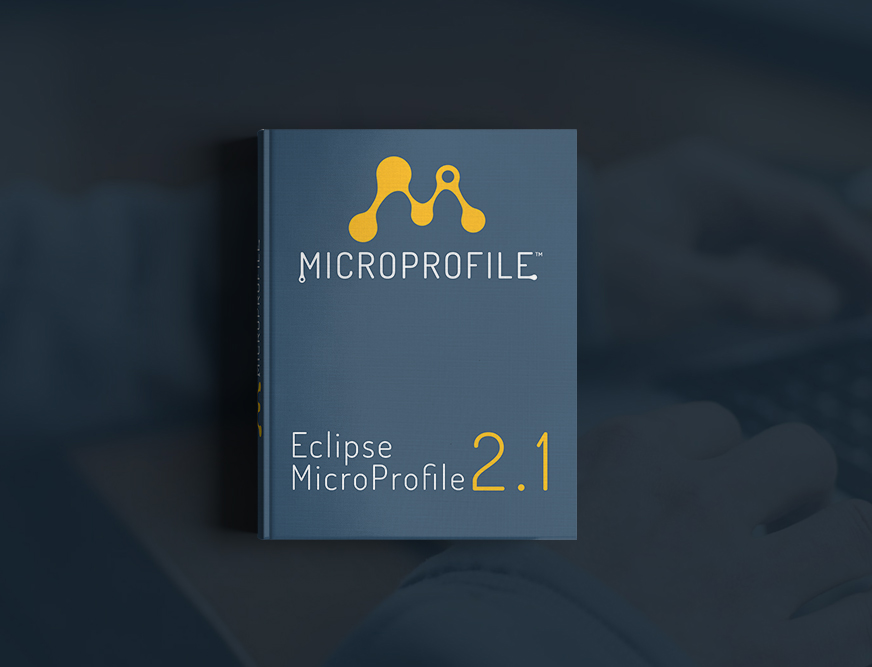Istio, seen as the leading service mesh model, released its version 1.0 in July 2018. It has generated massive interest, judging from conference talks and blog posts. Have you ever wondered how you can develop a cloud-native microservice deployed on Istio and be confident about its performance? In other words,…
SouJava created a series of videos with the main implementers of Microprofile, each video is composed of members representing Payara, Tomitribe, IBM and Red Hat. In addition to having done two talks with members of SouJava that can be seen here: MicroProfile – Rhuan Henrique – pt-br Encontro técnico de…
Updated on: December 3, 2018 The Eclipse MicroProfile project would like to announce the availability of our e-book titled “Eclipse MicroProfile: Accelerating Cloud-Native Application Development with Java Microservices”. This new publication provides a high-level overview of the business value that the MicroProfile project can bring to an organization that is…
Fault Tolerance provides annotations which allow you to easily apply common fault mitigation strategies to your application but did you know that, since version 1.1, it also exports metrics which allow you to monitor these mitigation strategies?
Separate configuration from your microservices code with MicroProfile Config. Easily and dynamically change your app’s configuration by adding and modifying variables in your server config.
The Duke’s choice award has been around for 16 years and it recognizes individuals, organizations, projects, services, or any program related to Java innovation. This award celebrates extreme innovation using Java Technology. The Eclipse MicroProfile project was recognized this past Wednesday, October 24, 2018 by winning a Duke’s choice award. MicroProfile…

The Eclipse MicroProfile Contributors, an open forum to collaborate on enterprise Java microservices, would like to announce the release of Eclipse MicroProfile 2.1. Eclipse MicroProfile 2.1, which builds on the 2.0 version, updates the Open Tracing API. Like its previous version, MicroProfile 2.1 continues to align itself with Java EE…
Today is a great day. Today we introduce a new Java microservices frameworks and a new member of MicroProfile family. Please welcome Project Helidon — a new Java microservices framework from Oracle.
Get Kevin Sutter’s view on how the MicroProfile and Jakarta EE projects could be combined at some point. He describes the progress in establishing each of the two projects, the issues to consider as the projects become more established, and current steps that are being made towards a more integrated…
Heiko Rupp of Red Hat has started a German tutorial series on MicroProfile on his YouTube channel. The videos follow his presentation at Java-Forum-Stuttgart “MicroServices mit Eclipse MicroProfile entwickeln”. The first three episodes are Intro: what is MicroProfile and how to use it with the Thorntail server Rest-Client: how to use the RestClient…
Just back from Java Forum Stuttgart 2018, I want to share the great feedback you all gave me while and after my (and Heiko’s) presentations on JAX-RS (and MicroProfile).
Eclipse MicroProfile 1.4 and 2.0 are Now Available The Eclipse MicroProfile Contributors, an open forum to collaborate on Enterprise Java microservices, would like to announce the releases of Eclipse MicroProfile 1.4 and 2.0. With these releases, Eclipse MicroProfile offers the same level of functionality to be usable with either Java…
Adopt Java 10 and learn how to build and package a MicroProfile application using Java Module System in order to deploy it with a minimal JVM inside a container.
One of the most interesting concepts that made Java EE (and Java) appealing for the enterprise is its great backward compatibility, ensuring that years of investment in R&D could be reused in future developments.
Launched nearly two years ago, the Eclipse MicroProfile project is moving fast with four releases and eight subspecs having at least two implementations each.
An interesting read about James’ journey in becoming a MicroProfile committer, and why this journey is a good sign for Jakarta EE.
Get distributed tracking of your microservices, a standardised way (through OpenAPI) to describe your RESTful applications, and a type-safe approach to invoking RESTful services over HTTP in Open Liberty 18.0.0.1.
What’s that? You’d like distributed tracing of microservices, a standardised way to describe your RESTful applications, a type-safe approach for invoking RESTful services over HTTP, metrics for your microservices, external configuration of your microservices, the moon on a stick? Funny you should ask: Let me introduce you to Open Liberty…
Every developer has the goal of building the most resilient application possible. Due to the distributed nature of microservices, resiliency and handling failures gracefully is mandatory. The Java ecosystem has…
A previous article described the specifications in the Eclipse MicroProfile 1.2 release and the benefits for Java-based cloud-native applications. This article shows how software developers writing Java-based microservices can…
Configuration is an important aspect of programming. However, a standard approach to it has been missing in Java for a long time. A year ago, the MicroProfile project decided to change that. I’m glad I could be part of it…
The purpose of this blog post is to provide an overview of the APIs and specifications in the Eclipse Microprofile 1.2 release. In particular, I’ll try to connect these specifications and APIs with their architectural purpose…
Enterprise Java has been defined by two players: Spring on one side and Java Enterprise Edition on the other. The Java EE set of specifications was developed in…
The Eclipse MicroProfile Contributors, an open forum to collaborate on Enterprise Java Microservices, would like to announce the release of Eclipse MicroProfile 1.3. Eclipse MicroProfile 1.3, which builds on the 1.2 version, updates the Config and the Metrics APIs and adds the OpenAPI, OpenTracing, and Rest Client APIs. In a…
EclipseCon Europe happened in October 2017 in Ludwigsburg, Germany and featured a ton of Red Hat speakers…
This quick tutorial will show you how to build your next microservice with the recently updated Eclipse MicroProfile APIs…
Oracle has officially joined the group of prestigious member organizations that are supporting the Eclipse MicroProfile initiative. Oracle has been maintaining and running the Java EE standard for over fifteen years and recently announced that it was transitioning Oracle Java EE technologies to The Eclipse Foundation project called EE4J. Eclipse MicroProfile and EE4J…
The Eclipse MicroProfile Contributors, an open forum to collaborate on Enterprise Java Microservices, would like to announce the release of Eclipse MicroProfile 1.2. Eclipse MicroProfile 1.2, which builds on the 1.1 version, updates the Config API and adds the Health Check, Fault Tolerance, Metrics, and JWT Propagation APIs. In…
Just a little over a year ago, the MicroProfile initiative was born. The community first heard about it at the DevNation conference in San Francisco on the 27th June last year. During the keynote panel, the five founding members (Red Hat, IBM, Tomitribe, LJC, and Payara) announced their collaboration and their…
At yesterday’s Eclipse MicroProfile public hangout, we had two major announcements: First, that we have announced the content for the next major MicroProfile 1.1 release and, second, that we have a new MicroProfile logo.
Eclipse MicroProfile 1.1 is Now Available The Eclipse MicroProfile Contributors, an open forum to optimize Enterprise Java for a microservices architecture by innovating across multiple implementations and collaborating on common areas of interest with a goal of standardization, would like to announce the release of Eclipse MicroProfile 1.1. Eclipse MicroProfile…
Eclipse MicroProfile, an open forum to optimize Enterprise Java for a microservices architecture by innovating across multiple implementations and collaborating on common areas of interest with a goal of standardization, would like to announce its brand new logo. A few months ago, community members decided that our logo needed to…
The Eclipse MicroProfile is a specification for a set of APIs appropriate to building MicroServices. The project has existed for over a year now and is something that Payara is highly committed to. Readers who like to keep up-to-date with news from the Java community will probably already be aware of how the project has progressed in leaps…
As I write this blog post, on Tuesday 27th June 2017, I’m looking through memories of where I was on this day in 2016: participating in the keynote speech at Red Hat’s DevNation conference in San Francisco.
Java EE developers are now experimenting with microservices and they need a coherent way to optimize their development efforts. Over the years, Java EE has supported distributed application architectures based on RMI/IIOP, Web Services and REST. The Eclipse MicroProfile project is the next step in that evolution because it optimizes…
Organizations that have already embarked or are thinking about starting a digital transformation journey are assessing and looking for ways to leverage their Java EE expertise. IT development and operations have built Java expertise over years, and there is a challenge to balance their existing skill base with new digitally…
I want to take a quick break from the other series for a moment to do something I’ve been remiss about for a while: addressing a recent report by Gartner on the state of Java EE. Before doing so I decided the other day to read the article my friend…
I’ll keep this post shorter than the last one. Wow! 2016 was a turbulent year for Java EE.
I was recently pointed to Gartner’s Market Guide to Application Platforms report, written by Anne Thomas and Aasish Gupta. The report takes a very negative view of Java EE to the point that I thought I was reading an obituary. To summarize their report, “Run, Run Away” from Java EE. Hey, if…
MicroProfile is a community project with the mission of optimizing Enterprise Java for a microservices architecture. In a short period of time, MicroProfile has reached three important milestones:
At DevNation this week, a new Java EE profile was announced to help Enterprise Java make greater strides in working with microservices architectures.
Today at the DevNation conference in San Francisco, Red Hat’s Mark Little was joined on-stage by Alasdair Nottingham from IBM, Theresa Nguyen from Tomitribe, Mike Croft from Payara and Martijn Verburg from the London Java Community to announce a new community collaboration – MicroProfile – whose goal is to make it easier…
Today at the DevNation conference in San Francisco, Payara’s Mike Croft appeared onstage during the Keynote, joined by Mark Little from Red Hat, Alasdair Nottingham from IBM, Theresa Nguyen from Tomitribe and Martijn Verburg from the London Java User Group to announce a new community collaboration called MicroProfile.
The developers’ world is a mixture of evolutions and reinventing the wheel. When I was doing EJBs 1.0 back in 1998, I was doing Micro Services. But I had to wait 2014 for someone to give it a name, and 2016to see it officially arriving in Enterprise Java. So here we are: a Micro…
Today I learned why they have bright lights shining on the stage for Keynotes. It isn’t (as I had assumed) to ensure that the people on stage can be seen. It is to blind the presenters so they can’t see just how many people are watching them. Today I was…
